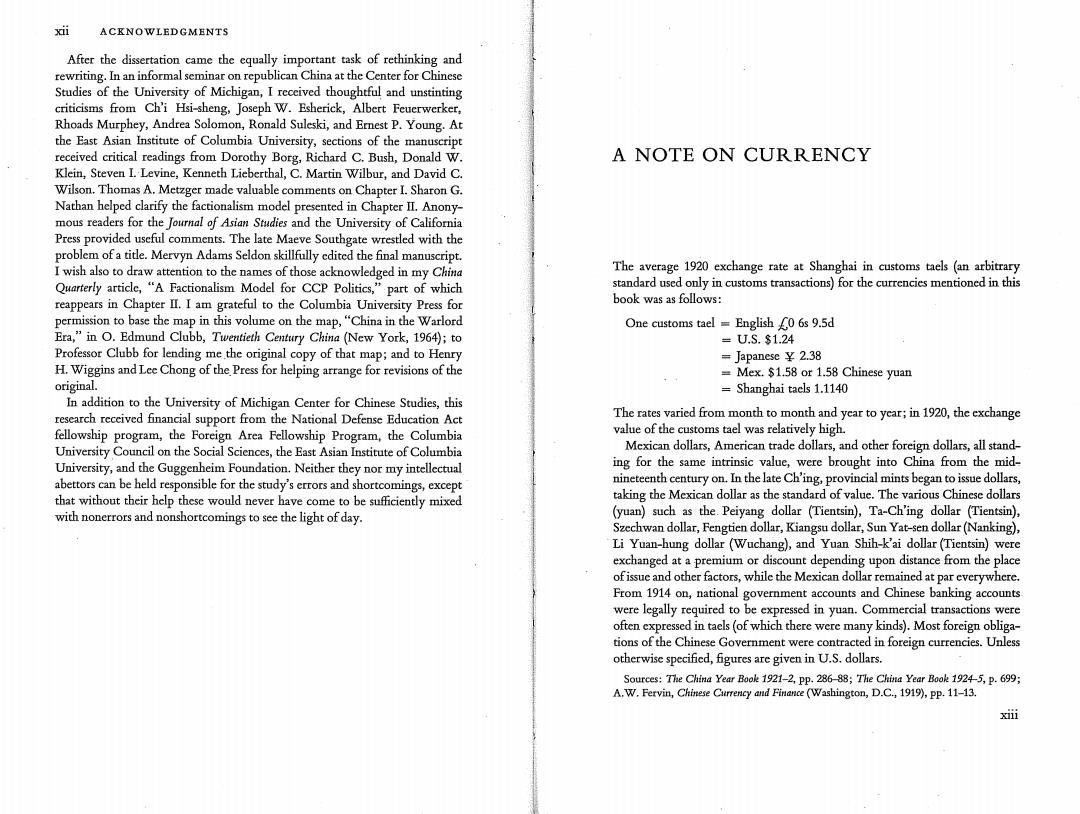正在加载图片...

xii ACKNOWLEDGMENTS After the dissertation came the equally important task of rethinking and rewriting.In an informal seminar on republican China at the Center for Chinese Studies of the University of Michigan,I received thoughtful and unstinting criticisms from Ch'i Hsi-sheng,Joseph W.Esherick,Albert Feuerwerker, Rhoads Murphey,Andrea Solomon,Ronald Suleski,and Ernest P.Young.At the East Asian Institute of Columbia University,sections of the manuscript received critical readings from Dorothy Borg,Richard C.Bush,Donald W. A NOTE ON CURRENCY Klein,Steven I.Levine,Kenneth Lieberthal,C.Martin Wilbur,and David C. Wilson.Thomas A.Metzger made valuable comments on Chapter I.Sharon G. Nathan helped clarify the factionalism model presented in Chapter II.Anony- mous readers for the Journal of Asian Studies and the University of California Press provided useful comments.The late Maeve Southgate wrestled with the problem of a title.Mervyn Adams Seldon skillfully edited the final manuscript. I wish also to draw attention to the names of those acknowledged in my China The average 1920 exchange rate at Shanghai in customs taels (an arbitrary Quarterly article,"A Factionalism Model for CCP Politics,"part of which standard used only in customs transactions)for the currencies mentioned in this reappears in Chapter Il.I am grateful to the Columbia University Press for book was as follows: permission to base the map in this volume on the map,"China in the Warlord One customs tael English 0 6s 9.5d Era,"in O.Edmund Clubb,Twentieth Century China (New York,1964);to =U.S.$1.24 Professor Clubb for lending me the original copy of that map;and to Henry =Japanese¥2.38 H.Wiggins and Lee Chong of the Press for helping arrange for revisions of the Mex.$1.58 or 1.58 Chinese yuan original. Shanghai taels 1.1140 In addition to the University of Michigan Center for Chinese Studies,this research received financial support from the National Defense Education Act The rates varied from month to month and year to year;in 1920,the exchange fellowship program,the Foreign Area Fellowship Program,the Columbia value of the customs tael was relatively high. University Council on the Social Sciences,the East Asian Institute of Columbia Mexican dollars,American trade dollars,and other foreign dollars,all stand- University,and the Guggenheim Foundation.Neither they nor my intellectual ing for the same intrinsic value,were brought into China from the mid- abettors can be held responsible for the study's errors and shortcomings,except nineteenth century on.In the late Ch'ing,provincial mints began to issue dollars, that without their help these would never have come to be sufficiently mixed taking the Mexican dollar as the standard of value.The various Chinese dollars with nonerrors and nonshortcomings to see the light of day. (yuan)such as the.Peiyang dollar (Tientsin),Ta-Ch'ing dollar (Tientsin), Szechwan dollar,Fengtien dollar,Kiangsu dollar,Sun Yat-sen dollar(Nanking), Li Yuan-hung dollar(Wuchang),and Yuan Shih-k'ai dollar (Tientsin)were exchanged at a premium or discount depending upon distance from the place of issue and other factors,while the Mexican dollar remained at par everywhere. From 1914 on,national government accounts and Chinese banking accounts were legally required to be expressed in yuan.Commercial transactions were often expressed in taels (of which there were many kinds).Most foreign obliga- tions of the Chinese Government were contracted in foreign currencies.Unless otherwise specified,figures are given in U.S.dollars. Sources:The China Year Book 1921-2,pp.286-88;The China Year Book 1924-5,p.699; A.W.Fervin,Chinese Currency and Finance (Washington,D.C1919),Pp.11-13. xiii